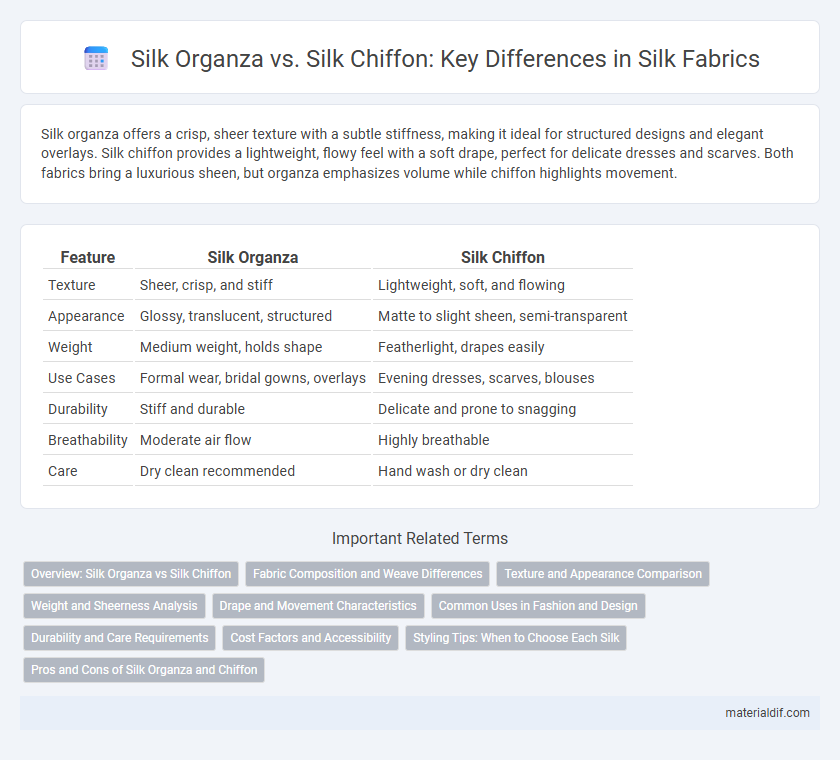Silk organza offers a crisp, sheer texture with a subtle stiffness, making it ideal for structured designs and elegant overlays. Silk chiffon provides a lightweight, flowy feel with a soft drape, perfect for delicate dresses and scarves. Both fabrics bring a luxurious sheen, but organza emphasizes volume while chiffon highlights movement.
Table of Comparison
| Feature | Silk Organza | Silk Chiffon |
|---|---|---|
| Texture | Sheer, crisp, and stiff | Lightweight, soft, and flowing |
| Appearance | Glossy, translucent, structured | Matte to slight sheen, semi-transparent |
| Weight | Medium weight, holds shape | Featherlight, drapes easily |
| Use Cases | Formal wear, bridal gowns, overlays | Evening dresses, scarves, blouses |
| Durability | Stiff and durable | Delicate and prone to snagging |
| Breathability | Moderate air flow | Highly breathable |
| Care | Dry clean recommended | Hand wash or dry clean |
Overview: Silk Organza vs Silk Chiffon
Silk organza is a lightweight, sheer fabric with a crisp texture and a slightly stiff hand, often used in structured garments and overlays, providing a delicate yet defined silhouette. Silk chiffon, by contrast, is a soft, flowing fabric with a smooth, semi-transparent surface, prized for its drape and airy feel, ideal for fluid designs like dresses and scarves. Both fabrics are made from silk fibers but differ significantly in weave and finish, influencing their weight, texture, and typical applications in fashion design.
Fabric Composition and Weave Differences
Silk organza is made from pure silk fibers woven in a tight, plain weave that creates a crisp and sheer texture, providing structure and a slightly stiff hand feel. Silk chiffon, composed of finely twisted silk yarns, features a loose, balanced plain weave that results in a lightweight, soft, and semi-transparent fabric with a fluid drape. The differences in weave density and yarn treatment between organza and chiffon significantly affect their texture, sheen, and suitability for various garment styles.
Texture and Appearance Comparison
Silk organza has a crisp, sheer texture with a structured, stiff hand that holds its shape, making it ideal for voluminous designs, while silk chiffon features a soft, lightweight, and fluid texture that drapes smoothly and creates a delicate, ethereal appearance. Organza's semi-transparent surface reflects light with a subtle sheen, imparting a polished, elegant look, whereas chiffon offers a matte finish with a slightly grainy feel that enhances its airy, romantic allure. Both fabrics are prized in haute couture, with organza favored for architectural silhouettes and chiffon chosen for flowing, graceful garments.
Weight and Sheerness Analysis
Silk organza is a lightweight, crisp fabric known for its sheer, stiff texture, making it ideal for structured garments and overlays. In contrast, silk chiffon is also lightweight but softer and more fluid, with a slightly less sheer quality that lends itself to flowing designs and delicate draping. The difference in weight and sheerness defines their distinct uses in high-end fashion; silk organza typically weighs around 30-40 grams per square meter, while silk chiffon ranges from 20-30 grams per square meter, offering varying degrees of transparency and texture.
Drape and Movement Characteristics
Silk organza features a crisp, structured drape that holds shape firmly, making it ideal for voluminous designs and architectural silhouettes. In contrast, silk chiffon offers a soft, fluid movement with a lightweight, sheer texture that flows gracefully, enhancing delicate and airy garment styles. Both fabrics exhibit distinct drape and movement qualities that cater to different design aesthetics and functional purposes.
Common Uses in Fashion and Design
Silk organza is commonly used in structured garments such as bridal gowns, evening dresses, and decorative overlays due to its crisp texture and ability to hold shape. Silk chiffon, with its lightweight and sheer quality, is favored for flowing dresses, blouses, scarves, and delicate layering, providing soft drape and elegance. Designers often combine silk organza and chiffon to balance structure and fluidity in couture collections and high-end fashion pieces.
Durability and Care Requirements
Silk organza is more durable than silk chiffon due to its tightly woven structure, making it less prone to snagging and tearing. Silk chiffon, while lightweight and sheer, requires more delicate handling and specialized care to maintain its integrity. Both fabrics demand gentle hand washing or professional dry cleaning to preserve their texture and longevity.
Cost Factors and Accessibility
Silk organza generally commands a higher price than silk chiffon due to its more complex weaving process and stiffer texture, which requires specialized craftsmanship. Accessibility to silk organza is more limited as it is often sourced from niche suppliers and used in high-end fashion, whereas silk chiffon is widely available and more affordable, making it a popular choice for various apparel. Cost factors for both fabrics include raw silk quality, production intricacy, and regional availability, with organza consistently positioned as the premium option.
Styling Tips: When to Choose Each Silk
Silk organza offers a structured, crisp texture ideal for formal wear, bridal gowns, and evening dresses that require volume and shape, while silk chiffon provides a lightweight, sheer drape perfect for flowing gowns, scarves, and layering in warmer weather. Choose silk organza for designs needing a polished, architectural silhouette and silk chiffon when aiming for soft, romantic, and fluid styling. Both fabrics highlight silk's natural sheen but cater to different aesthetic and functional needs in fashion design.
Pros and Cons of Silk Organza and Chiffon
Silk organza offers a crisp, structured texture that holds shape well, making it ideal for formal gowns and overlays, but it can feel stiff and less breathable compared to softer fabrics. In contrast, silk chiffon is lightweight and sheer with a flowing drape, perfect for delicate, airy designs, though it is more prone to snagging and requires careful handling. Both fabrics showcase luxurious silk fibers, but organza excels in volume and durability, while chiffon prioritizes softness and elegance.
Silk organza vs Silk chiffon Infographic

 materialdif.com
materialdif.com